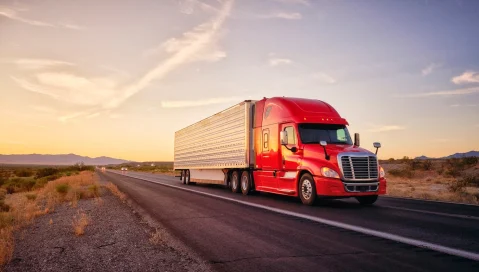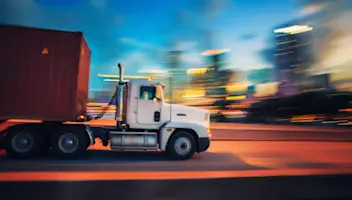Featured in this post
Driverless Trucks: What Does the Future Hold for Your Logistics Operations?
Driverless Trucks: What Does the Future Hold for Your Logistics Operations?
Apr 10, 2024
Aptean Staff Writer
Buckle up, driverless trucks will soon be more prevalent on U.S. public roads, but the question still remains: how will autonomous trucks impact your logistics operations in the coming years?
With self-driving tech companies, like Aurora, Kodiak and Gatik, aiming to remove human drivers inside the cabs of massive driverless trucks before 2024 ends, the future is almost here—with rubber finally set to meet the road in many states.
The idea of a Class 8 truck driving on its own on public roads has sparked excitement, anticipation and concern. In particular, for logistics leaders like you, the thought of delivering goods with greater efficiency and reduced costs is promising, but there’s still a lot to learn and more testing and development needed.
This blog will give you a glimpse of the milestones as self-driving trucks become more prevalent in the U.S. and how this modern technology could eventually benefit your logistics operations. We’ll also discuss some challenges and concerns to understand why it will still take years before unmanned semis operate on highways.
Additionally, this blog covers how transportation software could streamline your operations today, while waiting for autonomous trucks to become a reality—helping you navigate the road to a more efficient and resilient supply chain.
Level 4 Automated Trucks Are Actively Being Tested on U.S. Roads
The Society of Automotive Engineers released the SAE J3016 that defines the six levels of driving automation. Level 0-3 automated vehicles require a human driver, while Levels 4 and 5 vehicles can drive on their own. Most of the self-driving trucks being tested today fall under the Level 4 category.
Following TuSimple’s successful completion of an 80-mile drive from Tucson to Phoenix, Arizona in 2021, tech startups have become optimistic about commercializing the technology.
Self-driving semis with a human “safety driver” onboard are actively being tested to ship products in many parts of the U.S. In most tests, the driver only monitors the truck’s movement while the software does all the driving.
States across the country have enacted legislation for driverless vehicles. Many states in the Sun Belt region, like Florida, North Carolina, Georgia and Texas, have enacted policies allowing Level 4 or 5 capable vehicles to operate on public roads without a human driver onboard. Meanwhile, California, Indiana and New York states wouldn’t enable driverless trucks to operate without the presence of a qualified human driver inside the massive vehicles.
Potential Benefits of Driverless Trucks
By eliminating the “human error” element in big rigs, autonomous driving software developers believe driverless trucks could improve safety by preventing crashes due to fatigue, intoxication, distraction and road rage.
The Federal Motor Carrier Safety Administration (FMCSA) identified over-the-counter and prescription drug use, unfamiliarity with roadways, inadequate surveillance and fatigue as associated crash factors—all of which are attributed to human drivers.
Self-driving semis are equipped with high-powered cameras, sensors and radars, including remote-sensing technology called LiDAR (Light Detection and Ranging) to potentially eliminate the need for the presence of a human driver. This removes the “human element” in crashes, and it doesn’t need to comply with hours of service regulations or take sleep breaks and doesn’t get distracted.
Whether you’re a third-party logistics (3PL) provider, a wholesaler or a manufacturer who owns a fleet, driverless truck technology is beneficial in several ways:
Extended operations, moving products during off-peak hours without the need to comply with hours of service
Reduced labor costs and helping to address the impact of the truck driver shortage
Consistent and reliable transportation of products, ensuring timely pickup and delivery schedules, eliminating the possibility of drivers being absent
More optimized driving patterns because driverless trucks can access and analyze real-time traffic data to choose the shortest or least congested routes, potentially saving time and fuel
Full Adoption of Driverless Trucks Will Take Years
Industry experts believe it will take up to a decade before the public comfortably shares the roads with massive driverless trucks.
Full autonomy is just one part of the equation of self-driving trucks. Although startups and proponents have become confident in the reliability of driverless technology, they also need to address pressing concerns related to legislation, cybersecurity and insurance underwriting.
Advocates hail unmanned trucks as a safer alternative, but 2022 saw around 400 crashes involving compact vehicles with partially automated driver assist systems (ADAS), raising concerns. Will the public trust 80,000 lbs. self-driving trucks to share the road?
Moreover, electrification is another issue for startups. While fully electric driverless trucks are beneficial for companies aiming for cleaner, low-emission alternatives, today’s electric-powered trucks only travel limited distances, and there are very few charging stations for cargo trucks. Experts estimate that it will take 15 years before these electrified alternatives dominate the industry.
Future Proofing Your Business With Transportation Software
Driverless trucking could be a potential solution to increase efficiency in delivering goods. However, companies behind modern technology and trucking industry experts need to address all the concerns surrounding self-driving trucks for a smooth transition and to ensure public safety.
Since driverless trucks have a long way to go to prove their reliability, you’ll need to take advantage of proven solutions like a transportation management system (TMS) or route optimization software to ensure the most efficient utilization of your fleet and drivers.
On a high level, these solutions could empower your operations by achieving efficient multimodal transportation, optimizing carrier selection and gaining increased fleet visibility. Additionally, you can also access real-time data to help you make more informed business decisions.
Implementing transportation software could help future-proof your business as you wait for the real-world deployment of fully autonomous trucks.
Ready to learn more about the future of driverless trucks?
Download our whitepaper, Driving Innovation: The Rise of Driverless Trucks in Logistics, to learn more about the future with self-driving trucks and what transportation software can do to elevate your business operations.
Related Content





Ready to start transforming your business?
We’ve got the specialized TMS solutions you need to conquer your industry challenges.



